- Author: Kathy Keatley Garvey
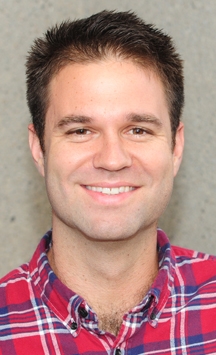
If you enroll in a beekeepers' course at the Harry H. Laidlaw Jr. Honey Bee Research Facility at the University of California, Davis, one of the instructors you're likely to meet is Charley Nye, manager of the facility.
Meet Charley Nye, behind the veil.
Charley remembers distinctly when bees first drew his interest.
As an undergraduate at the University of Illinois, Urbana-Champaign, he enrolled in an introductory entomology class. “I remember seeing the research technician standing in and indoor flight cage, surrounded by bees,” Nye said. “They were flying from the hive to a feeder stand and completely ignoring her. We covered the long history of beekeeping in that class around that same time and I was just amazed at how much knowledge had been collected. I applied for a job and started working as an assistant to the research technician I saw that day that spring. I spent the next three summers working for the lab of Dr. Gene Robinson and learning as much as I could.” (Note: Access this YouTube video to hear Gene Robinson speak on " Me to We: Using Honey Bees to Find the Genetic Roots of Social Life" at the Feb. 22, 2016 UC Davis Chancellor's Distinguished Speakers' Colloquium.)
Charley went on to spend eight years in Illinois working with the bees—three as an undergraduate assistant and five years as the facility manager and research technician. He joined UC Davis in December 2015.
“Adapting to the California ecosystem has been a bit of an adjustment,” Nye said. “A big part of beekeeping is understanding the ecosystem you live in. If you've got a bee yard that doesn't have a water source close, you may need to move water in during dry periods. Different flowers provide nectar and pollen at varying quantities, so being aware of what's going on in the environment can give you some insight into whether or not you might need to assist your bees with some sugar to make it until the next bloom. That has honestly been my favorite part of moving here, learning about all the trees and shrubs and wildflowers and when they bloom. It's a constant process through the year, and being my first year here it's been really enjoyable to watch the seasons progress."
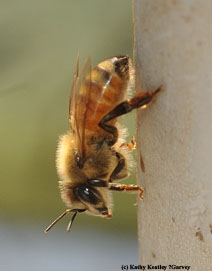
"I think the general public's knowledge of bees has made amazing advances in recent years. The shortage of bees for agricultural purposes here in the Central Valley really brought beekeeping into the news, followed by a lot of documentaries and things that made people want to be beekeepers or at least plant pollinator friendly gardens. Lots of people bring up beekeeping documentaries they've seen, and I don't think beekeepers were experiencing that 20 years ago. Overall, I'm mostly impressed with the amount of bee related knowledge out in the world right now.
Myths and misconceptions about bees? Often people associate bees with stinging, and falsely claim they have an allergy. “I've been doing this long enough that I don't laugh at people when they tell me they are allergic, but I think people don't completely understand what allergic means,” he said. “Only one or two people out of 1000 are actually allergic and have a life threatening reaction--most people just experience pain and swelling. I try to point out to people that when it hurts and makes their hand swell up, that might not mean they have a bee allergy, but most of the time I just nod my head and move on. I worked a booth at a local fair and half my conversations were people telling me they were allergic because it hurt. I get stung every day, and I can attest that at no point does it stop hurting.”
Nye divides his time with the labs of Extension apiculturist Elina Niño, pollination ecologist Neal Williams, and Brian Johnson, who studies the behavior, evolution and genetics of honey bees. “My responsibilities are pretty spread out,” he said. “The majority of my time is spent keeping the bees healthy enough for experiments.” In peak season, “it's pretty common to just have a few weeks' notice that we need any number of healthy full sized colonies, and like other animals, you can't grow a calf to a full sized cow with any magic tricks, so we try to buffer that by keeping a tight schedule for disease monitoring and making sure all our colonies are as robust as possible.”
What does he like the best about his job? The least?
"My job has a great balance between working out in a natural setting going through bee hives, and coming back to the lab and getting involved in research," he said. "I think doing either one of them by themselves would get a little tedious for me, so I feel really lucky to be able to split myself between the two. The least? It might be kind of a strange complaint, but foxtails. I spend a lot of time walking through tall grass and those foxtails burrow into my shoes and make me crazy. And I'm told I have to worry about them going up my dog's nose? I would say it's an urban myth but the seeds ability to get into my shoe and under my sock is practically magic."
(Editor's Note: Here's a list of the 2017 apiculture courses that the E. L. Niño lab is teaching; registration is now underway.)

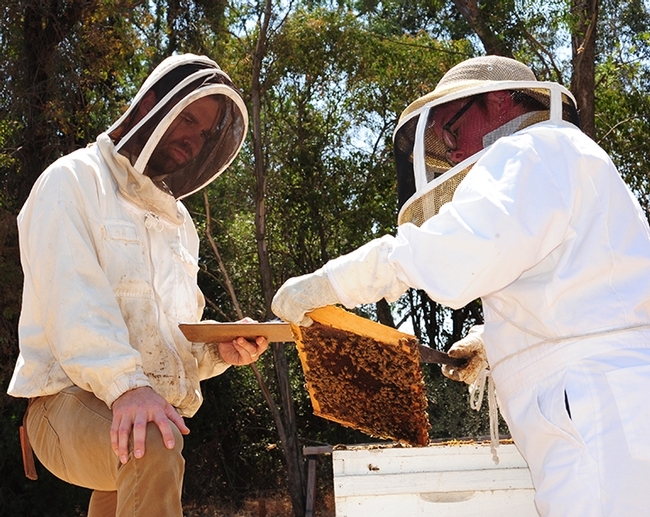
- Author: Kathy Keatley Garvey
A number of eminent bee scientists will be speaking soon at UC Davis. They include David Tarby, Gene Robinson and Dennis vanEngelsdorp.
David Tarpy, Wednesday, Feb. 3
Extension apiculturist/professor David Tarpy of North Carolina State University will present a seminar on "Young Regality: a Day in the Life of a Virgin Queen Bee" from 12:10 to 1 p.m., Wednesday, Feb. 3 in 122 Briggs Hall, Kleiber Hall Drive, UC Davis.
The seminar, free and open to all interested persons, is part of the UC Davis Department of Entomology and Nematology's noonhour seminars. It also will be recorded for later posting on UCTV. His host is Elina Niño, Extension apiculturist, UC Davis Department of Entomology and Nematology.
"Social insects have long fascinated entomologists, and honey bees have been a model system for their study," said Tarpy, who received his doctorate in entomology at UC Davis in 2000 with major professor Robert Page, former chair of the Department of Entomology and now university provost emeritus and Foundation chair of Life Sciences, Arizona State University. "At the heart of the colony is a single queen, the mother of all nestmates and critical member for colony productivity. The natural history of queens is a fascinating story, one that interweaves the complexities of social behavior, genetics, and evolutionary ecology."
Tarpy joined the North Carolina State University faculty in 2003 after completing a postdoctoral fellowship with Tom Seeley of Cornell University. He received his bachelor's degree in biology in 1993 from Hobart College and his master's degree in biology in 1995 from Bucknell University.
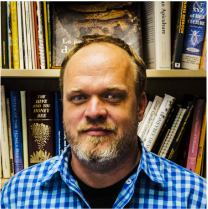
Gene Robinson, Monday, Feb. 22
Eminent honey bee scientist Gene E. Robinson of the University of Illinois at Urbana-Champaign will speak on “Me to We: Using Honey Bees to Find the Genetic Roots of Social Life” at the UC Davis Chancellor's Colloquium on Monday, Feb. 22 in Jackson Hall, Mondavi Center for the Performing Arts. This was initially scheduled to take place in the Vanderhoef Studio Theatre, but has been changed due to the increasing registration.
His presentation, part of the Chancellor's Colloquium Distinguished Speakers Series, is from 4 to 6:30 p.m. Registration is underway on the Chancellor's Colloquium series website. The event is free and open to the public but registration is required.
Robinson pioneered the application of genomics to the study of social behavior and led the effort to sequence the honey bee genome.
Robinson is the University Swanlund chair and directs the Institute for Genomic Biology (IGB) and the Bee Research Facility. He received his doctorate in entomology from Cornell University in 1986 and joined the faculty of the University of Illinois at Urbana-Champaign in 1989.
Dennis vanEngelsdorp, Saturday, May 7
The second annual UC Davis Bee Symposium is scheduled Saturday, May 7, with details forthcoming. We do know, however, that bee scientist Dennis vanEngelsdorp of the University of Maryland will be among the featured speakers, according to Amina Harris, director of the UC Davis Honey and Pollination Center, and Extension apiculturist Elina Niño, of the UC Davis Department of Entomology and Nematology. So mark your calendars for this all-day symposium.
Van Engelsdorp says on his website: "My research focus on pollinator health, and honey bee health specifically. I am particularly intrigued with using an epidemiological approach to understanding and (importantly) improving honey bee health. This approach is multi-faceted, requiring understanding both the etiology of individual bee diseases and the large scale monitoring of colony health."
Van Engelsdor presented an outstanding TED talk on "A Plea for Bees" back in July of 2008 and you can watch it here. The teaser: "Bees are dying in droves. Why? Leading apiarist Dennis vanEngelsdorp looks at the gentle, misunderstood creature's important place in nature and the mystery behind its alarming disappearance."
If you missed the 2015 UC Davis Bee Symposium, you missed hearing Marla Spivak, the distinguished McKnight Professor in the Department of Entomology at the University of Minnesota and winner of a MacArthur Genius Grant, deliver the keynote address. She delivered a TED talk in June of 2003 on our disappearing bees and you can watch it here.
Meanwhile, check out the Honey and Pollination Center website to see photos and data from the inaugural UC Davis Bee Symposium. UC Davis is the place to "bee" to learn about bees.
The bees are a'buzzing!

- Author: Kathy Keatley Garvey
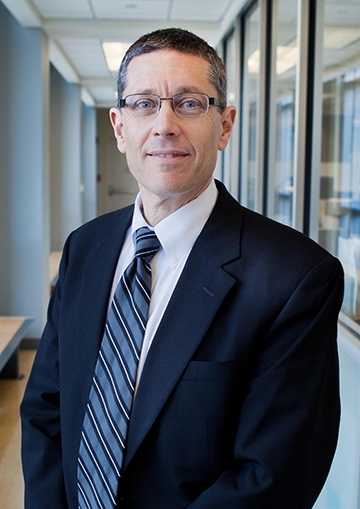
That's when eminent honey bee scientist Gene E. Robinson of the University of Illinois at Urbana-Champaign will speak on “Me to We: Using Honey Bees to Find the Genetic Roots of Social Life” in Jackson Hall, Mondavi Center for the Performing Arts, UC Davis campus.
His presentation, part of the Chancellor's Colloquium Distinguished Speakers Series, is from 4 to 6:30 p.m. Registration is underway on the Chancellor's Colloquium series website. The event is free and open to all interested persons but registration is required. (See Colloquium series website to register.)
Robinson pioneered the application of genomics to the study of social behavior and led the effort to sequence the honey bee genome.
Many of us have heard him speak, and many more have read his work. You may have heard him present a Tedx Talk, or read his piece on "The Behavior of Genes" (New York Times). Science writer Nick Zagorski profiled him in the Proceedings for the National Academy of Sciences (PNAS).
Robinson needs no introduction; his work is legendary. He is the University Swanlund chair and directs the Institute for Genomic Biology (IGB) and the Bee Research Facility. He received his doctorate in entomology from Cornell University in 1986 and joined the faculty of the University of Illinois at Urbana-Champaign in 1989.
He served as interim director of IGB, 2011-2012; director of the Neuroscience Program, 2001-2011; and leader of the Neural and Behavioral Plasticity Theme at the IGB, 2004-2011.
Robinson has authored or co-authored more than 275 publications, including 26 published in Science or Nature. He has been the recipient or co-recipient of more than $50 million in funding from the National Science Foundation, National Institutes of Health, U.S. Department of Agriculture and private foundations; pioneered the application of genomics to the study of social behavior; led the effort to gain approval from the National Institutes of Health for sequencing the honey bee genome; and founded the Honey Bee Genome Sequencing Consortium.
In addition, Robinson serves on the National Institute of Mental Health Advisory Council and has past and current appointments on scientific advisory boards for companies with significant interests in genomics.
His honors include University Scholar and member of the Center of Advanced Study at the University of Illinois; Burroughs Wellcome Innovation Award in Functional Genomics; Founders' Memorial Award from the Entomological Society of America; Fulbright Senior Research Fellowship; Guggenheim Fellowship; NIH Pioneer Award; Honorary Doctorate from Hebrew University; Fellow, Animal Behavior Society; Fellow, Entomological Society of America; Fellow, American Academy of Arts and Sciences; and member of the U.S. National Academy of Sciences.
A native of Buffalo, N.Y., Robinson received his doctorate in entomology from Cornell University, Ithaca, N.Y., in 1986. What prompted him to study entomology? You'll need to read Nick Zagorski profile of him in the Proceedings for the National Academy of Sciences (PNAS).
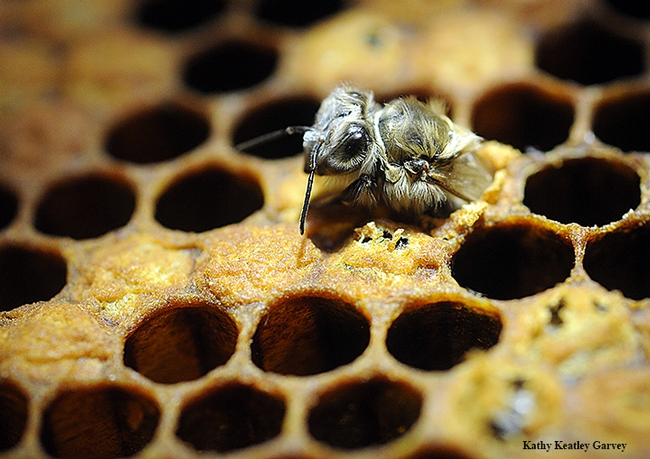
- Author: Kathy Keatley Garvey
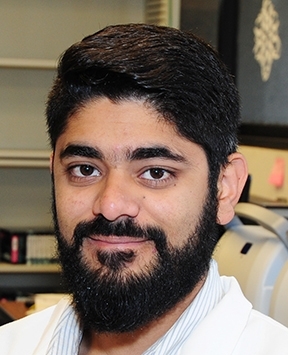


There's exciting news today out of the Department of Entomology and Nematology, University of Califoirnia, Davis.
A team of researchers--two faculty members and a graduate student--just published a paper on bee immunity and toxin metabolism today (Nov. 9) in Scientific Reports, part of the Nature Publishing Group. The team: assistant professor Rachel Vannettte; and assistant professor Brian Johnson and his graduate student, Abbas Mohamed.
The journal article is titled Forager Bees (Apis mellifera) Highly Express Immune and Detoxification Genes in Tissues Associated with Nectar Processing.
When honey bees shift from nurse bees to foragers, or from caring for the brood to foraging for nectar and pollen, the bees “turn on” gene expression with products that protect against microorganisms and degrade toxins, they discovered,
“First, the results suggest that forager bees may use antimicrobial peptides—short sequences of amino acids with general activity-- to reduce microbial growth in stored food resources,” said Vannette, who joined the faculty in September as assistant professor after a postdoctoral fellowship at Stanford University. “This would be a largely unrecognized way that bees protect honey and potentially other stored resources from microbial spoilage. Second, this work shows that forager bees produce toxin-degrading enzymes in nectar-processing tissues.”
“This may allow forager bees to degrade many different kinds of compounds in nectar, before it is stored,” Vannette said. “Bees also vary in their ability to do this—foragers have a greater ability to degrade a variety of compounds than nurses. This may have implications for hive health and management.”
The scientists found the change in nectar-processing tissues, but not in the gut. The scientists surmised that the exposure to bacteria or yeasts in the environment may trigger this change, but they did not examine it in the study. it in the study.
"Nice paper,” said Gene Robinson, director of the Institute for Genomic Biology and Swanlund Chair of Entomology, University of Illinois at Urbana-Champaign, who was not involved in the research. “It had been well known that the division of labor in a honey bee colony is supported by extensive differences in brain gene expression between bees that perform different jobs. This new research shows nicely that this genomic differentiation extends beyond the brain; different complements of active genes in a variety of tissues make each bee better suited for the job it needs to perform."
The team plans to follow up with functional assays to examine the potential of these gene products to (1) reduce microbial growth and (2) degrade a variety of natural and synthetic compounds.
So, we're anxiously awaiting to hear more!





